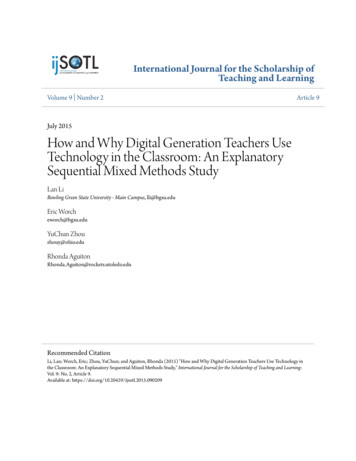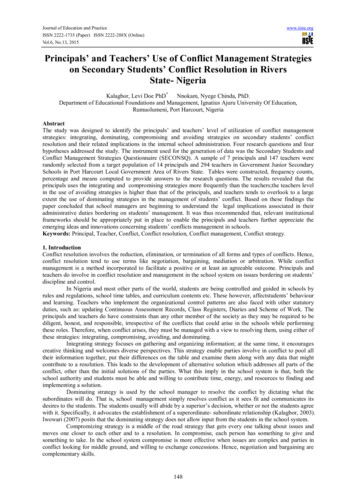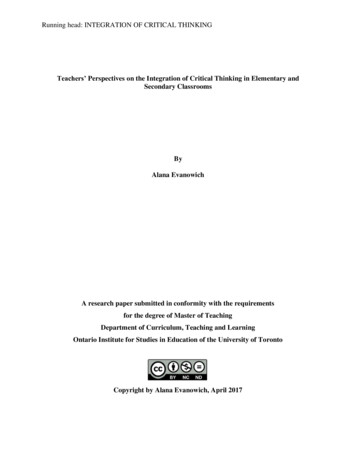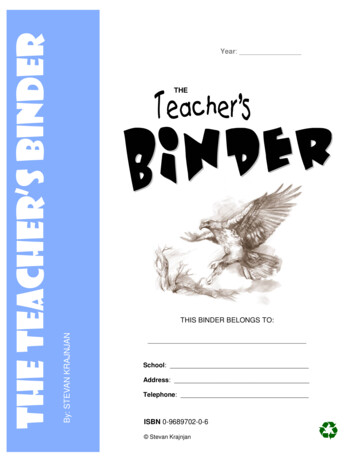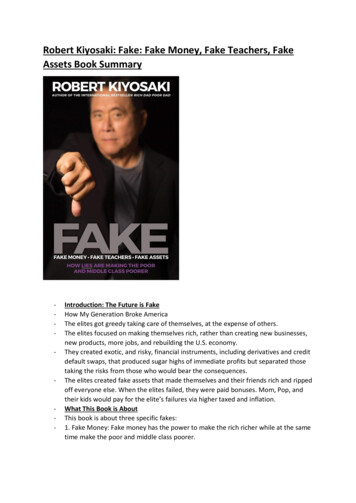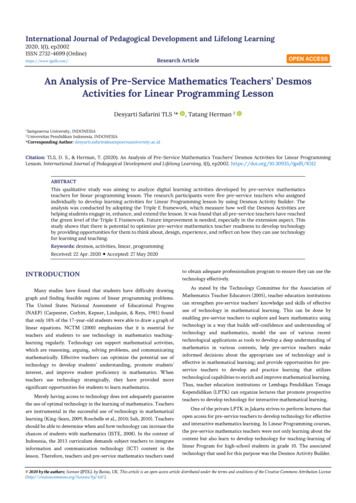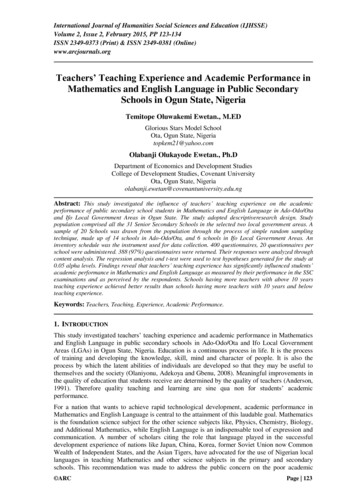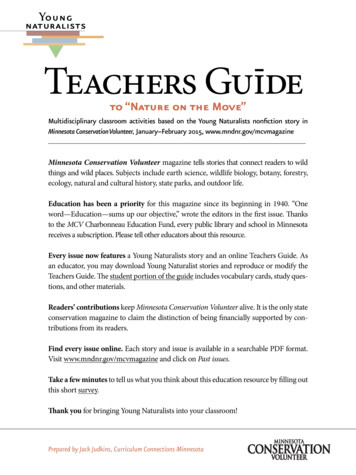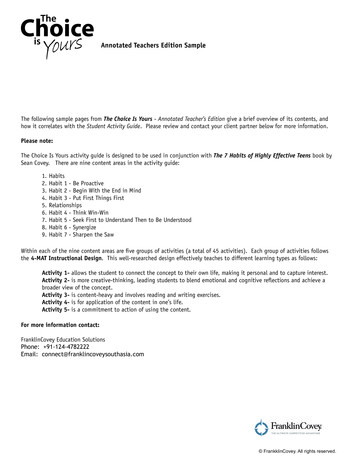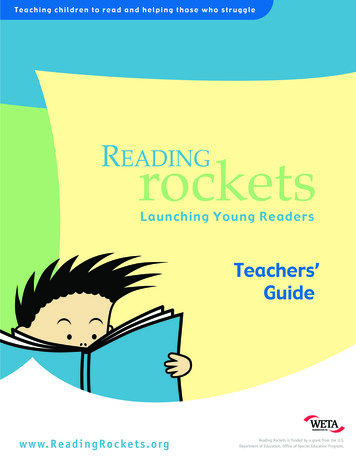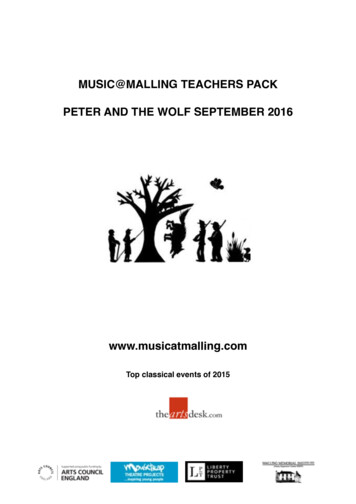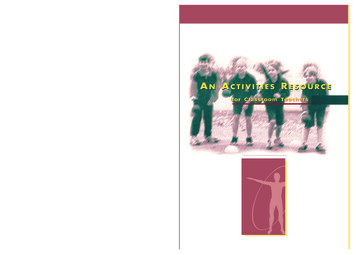
Transcription
An activities resource designed foruse by primar y teachers in theteaching of fundamental motor skillsto students in their formative years.Fundamental Motor Skills contributeto lifelong participation in physicalactivity.
Fundamental Motor SkillsAn Activities Resource For Classroom TeachersFundamental Motor Skills Activities Resource
State of VictoriaDepartment of Education, Victoria, 1998Printed June 1998Updated as a web based resource in relation to the Victorian Essential Learning Standards 2009ISBN 0-7306-9082-2AcknowledgementsThe Department of Education is pleased to acknowledge the following individuals for their contribution to the development andpublication of this resource for teachers.Project ManagementIan MaddisonMary Wilson (ACHPER Victorian Branch)WritersDr Jeff Walkley (Coordinating Writer)Debra ArmstrongPhil ClohesyReviewersKerryn Andersen (ACHPER Victorian Branch)John BirchallIvan CocksSue KuefferRaeline McAlisterStephen MetcalfeTass NicolaGarry PowellMargaret PurchaseGraeme RenshawGayle RogersNoel StevensThe Department of Education welcomes any use of this publication within the constraints of the Copyright Act. Providedacknowledgement is made to the source, Victorian government and non-government schools are permitted to copy material freelyfor the purpose of teaching students in schools, or for communication with parents and others in the community. When a charge isauthorised for supplying material, such charge shall be limited to direct costs only. When the material is to be sold for profit, writtenauthority must first be obtained.Detailed requests for uses not specifically permitted by the Copyright Act should be submitted in writing to the Copyright Officer,Department of Education, GPO Box 4367, Melbourne Vic 3001, Australia.Published by the Physical and Sport Education Section, Department of Education, GPO Box 4367, Melbourne Vic 3001, Australia.Page ii Fundamental Motor Skills Activities Resource
Fundamental Motor SkillsAn Activities Resource For Classroom TeachersTable of rtical Jump36Overhand Throw46Ball Bounce56Leap66Dodge76Punt86Forehand Strike96Two-Hand Side-Arm StrikeActivity Index106116Fundamental Motor Skills Activities Resource Page iii
Page iv Fundamental Motor Skills Activities Resource
IntroductionAbout This Activities ResourceFundamental Motor Skills - An Activities Resource for ClassroomTeachers has been developed to complement the publicationFundamental Motor Skills - A Manual for Classroom Teachers(1996).It is recommended that this activities resource and the manual beused in conjunction with each other. By doing so, teachers willbe able to: identify the essential fundamental motor skills and theircomponents select activities to teach fundamental motor skills provide specific feedback to students evaluate student learning record student progress in a clear and understandable way.How to Use This Activities ResourceThe resource provides over 260 activities which teachers canincorporate into a school physical education program in theteaching of fundamental motor skills.The activities relate specifically to the 11 motor skills whichwere previously identified as those most essential for primaryschool students to master: Catch Kick Run Vertical Jump Overhand Throw Ball Bounce Leap Dodge Punt Forehand Strike Two-Hand Side-Arm StrikeEach of these skills is presented in a separate section incorporating24 activities. At the beginning of each skill section a commonformat includes: a series of teaching hints to assist the development ofcorrect technique the identification of common errors associated withlearning specific skills an activities summary chart which lists the activities withinthe specific skill section, provides a difficulty rating foreach activity and identifies skill components which can beemphasised in each activity.Although the activities have been rated according to difficulty,teachers may choose to modify an activity to a lower or higherdegree of difficulty according to the ability of students.Issues in Teaching Fundamental Motor SkillsWhen teaching these activities to students, it is recommendedthat teachers review the information from Sections A and B inFundamental Motor Skills - A Manual for Classroom Teachers(pages 3-14).The following information should be remembered when teachingfundamental motor skills: Fundamental motor skills should be taught as part of aphysical and sport education program, and not as anisolated skills program. Fundamental motor skills are not easy for students to learn.Teachers should aim to have students master a skill ratherthan just experience a skill.Most skills used in sports and movement activities areadvanced versions of fundamental motor skills. Forexample, throwing in softball and cricket, the baseballpitch, javelin throw, tennis serve and netball shoulder passare all advanced forms of the overhand throw (see Diagram 1).During the early primary school years (Prep - 3) studentsmust be given the opportunity to learn the essential motorskills upon which later learning is dependent. Thesefundamental motor skills are often used by students at play.Table 1 (see page 2) indicates the suggested levels at whichthe essential fundamental motor skills should be introducedand mastered.During the later primary years (Years 4 - 6) students shouldbe taught a broad range of transitional, or lead-up, motorskills and activities. Examples of skills and activities in thisgroup include the basketball dribble, modified netball,paddle tennis and modified baseball. The skills andactivities at this level may be combined or modified invarious ways, practised with or without equipment andtaught through individual practice or by incorporating theminto game structures.Mastery of these fundamental motor skills by students isnecessary if optimum development of higher level skills isto occur. Students who do not master these skills are lessable and often less willing to persist with the difficult taskof learning more complex motor skills, and will avoidactivities which expose them to ‘public failure’. Ultimately,such students become disillusioned and may rejectparticipation in physical activity as part of their allVolleyballBadmintonDiagram 1: Relationship Between Fundamental Motor Skills and Specific Sport Skills (Overhand Throw)(Source: Fundamental Motor Skills - a manual for Classroom Teachers, 1996)Fundamental Motor Skills Activities Resource Page 1
Fundamental Motor SkillPrepYear 1Year dVertical JumpIntroducedMasteredYear 3Year 4Year 5MasteredMasteredOverhand ThrowIntroducedMasteredBall eIntroducedMasteredPuntIntroducedForehand StrikeIntroducedMasteredMasteredTwo-hand Side-arm StrikeIntroducedMasteredTable 1: Suggested Levels for the Introduction and Mastery of Essential Fundamental Motor Skills(Source: Fundamental Motor Skills - a Manual for Classroom Teachers, 1996)Activities With a Learning FocusMany of the activities included in this resource can be played asgames. Games can be very motivating for students and, if usedappropriately, can aid students’ learning of fundamental motorskills. In contrast, games which are played for the sake ofplaying a game, without a learning focus, do not assist studentsin learning fundamental motor skills.Examples of a learning focus in a game include the highlightingof a fundamental motor skill or components of a fundamentalmotor skill, a game strategy, a discussion on how to workcooperatively or how to accept winning and losing.When an activity from this resource is used to teach afundamental motor skill, it is important that teachers: remind students of the skill which will be taught during thelesson, andinstruct students on how to perform the components of theskill throughout the lesson.Fundamental Motor Skills in the CurriculumIt is essential that the teaching of fundamental motor skills beintegrated into all areas of a school physical educationprogram.Students who engage in physical education develop theknowledge, skills, understanding and motivation to seek healthand physical competence through lifelong involvement inphysical activity. Physical education seeks to promote healthylifestyles among students.Physical education is the process through which sport and sporteducation, outdoor adventure activities, dance, gymnastics,aquatics, ball handling and athletics are used to help studentslearn motor skills and to learn about and achieve physical fitness(see Diagram 2). Physical education activities also assist theschool to develop personal and social skills in students.It is the responsibility of teachers to ensure that students in theirformative years, particularly in Years Prep - 3 develop basicphysical education skills. These include the development of theessential fundamental motor skills described in this resource.Examples of fundamental motor skills taught within the contextof physical and sport education area: Gymnastics: run, vertical jump, leap.Dance: dodge, run, vertical jump, leap.Athletics: overhand throw, leap, vertical jump, run.Outdoor Adventure Activities: dodge, run, leap, verticaljump, catch.Sport Education: ball bounce, punt, kick, overhand throw,vertical jump, leap, catch, two-hand side-arm strike.Ball Handling: overhand throw, kick, catch, ball bounce,forehand strike, two-hand side-arm strike, punt.KEY LEARNING AREASAND PHYSICALPhysical, Personal andHEALTHSocial LearningEDUCATIONKnowledge, skills and behavioursinHealth and Physical Education; Personal Learning;ENGLISHInterpersonal Development; Civicsand CitizenshipScope of Physical and Sport Education in SchoolsTHE ARTSDiscipline-based LearningKnowledge, skills and behavioursin OTHERLANGUAGESThe Arts; English and LanguagesOtherThan English;THAN ENGLISHThe Humanities; Mathematics; nterdisciplinary Learning SCIENCEKnowledge, skills and behaviours inCommunication; ormation and CommunicationsTechnology;AND ENVIRONMENT TAL MOTOR vitiesDiagram 2: Relationship of Fundamental Motor Skills to Physical and Sport Education CurriculumPage 2 Fundamental Motor Skills Activities ResourcePhysicalFitness
Fundamental Motor Skills and the VictorianEssential Learning Standards (VELS)The Victorian Essential Learning Standards (VELS) form the basisfor curriculum and assessment in Victorian schools. There arethree interrelated Strands (Physical, Personal and Social Learning;Discipline-based Learning; and Interdisciplinary Learning) whichunderpin the educational purpose, principles and values of theVELS.The Health and Physical Education (HPE) domain is includedin the Physical, Personal and Social Learning Strand. Withinthe HPE domain are two dimensions - Movement and PhysicalActivity and Health, Knowledge and Promotion.The Movement and Physical Activity dimension has a strongfocus on aquisition of motor skills, in: The Learning Focus Statements, which outline thelearning that students need to focus on if they are toprogress and achieve the Standards at the relevant level.(Refer to http://vels.vcaa.vic.edu.au/downloads/vels standards/velsrevisedhpe.pdf) The Standards, which define what students should know andbe able to do at different levels of schooling. They are theoutcomes against which student achievement will be assessedand reported on and provide valuable information aboutstudent progress which can form the basis of further teachingand intervention.The Standards for Levels 1- 4 of Movement and Physical Activityare indicated below which highlight the strong emphasis onFundamental Motor Skills:Level Movement and Physical Activity Dimension1At Level 1, students perform basic motor skills and movementpatterns, with or without equipment, in a range of environments.They regularly engage in periods of moderate to vigorous physicalactivity. They use simple vocabulary to describe movement, thephysical responses of their bodies to activity and their feelings aboutparticipation in physical activity. When participating in movementand physical activities, they follow rules and procedures and shareequipment and space safely.2At Level 2, students demonstrate basic motor skills and some morecomplex skills. They combine motor skills and movement patternsduring individual and group activities. They demonstrate controlwhen participating in locomotor activities requiring change ofspeed, direction and level. They create and perform simple rhythmicmovement sequences in response to stimuli. They regularly engagein sessions of moderate to vigorous physical activity and describethe link between physical activity and health. They explain thecontribution rules and procedures make to safe conduct of games andactivities. They use equipment and space safely.3At Level 3, students perform a broad range of complex motor skills.They demonstrate a wide variety of motor skills and apply them tobasic, sport-specific situations. They create and perform coordinatedmovement sequences that contain a variety of motor skills andmovement patterns. They participate regularly in physical activitiesfor the purpose of improving skill and health, and identify anddescribe the components of health-related fitness. They begin to usebasic games' tactics. They work with others to achieve goals in bothcooperative and competitive sporting and games situations, explainthe concepts of fair play, and respect the roles of officials. Studentsfollow safety principles in games and activities.4At Level 4, students perform confidently and efficiently in a rangeof movement environments (indoor, outdoor and aquatic). Theyrefine basic and complex motor skills and apply these skills inincreasing
Perceptual Motor Programs (PMP) PMP are usually offered to students in the lower grades and regularly involve parents as helpers. Small groups of students rotate through a number of activities. PMP can be modified to focus on the teaching of fundamental motor skills. Parents can be used to provide on-the-spot feedback,
